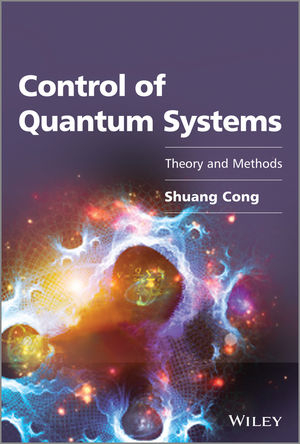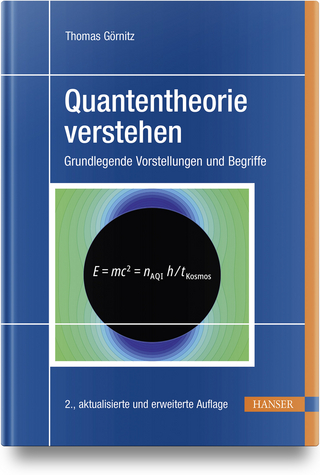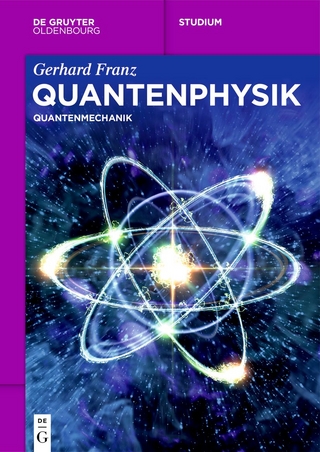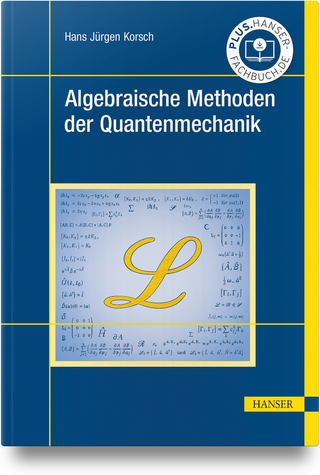
Control of Quantum Systems
John Wiley & Sons Inc (Verlag)
978-1-118-60812-8 (ISBN)
Advanced research reference examining the closed and open quantum systems
Control of Quantum Systems: Theory and Methods provides an insight into the modern approaches to control of quantum systems evolution, with a focus on both closed and open (dissipative) quantum systems. The topic is timely covering the newest research in the field, and presents and summarizes practical methods and addresses the more theoretical aspects of control, which are of high current interest, but which are not covered at this level in other text books.
The quantum control theory and methods written in the book are the results of combination of macro-control theory and microscopic quantum system features. As the development of the nanotechnology progresses, the quantum control theory and methods proposed today are expected to be useful in real quantum systems within five years. The progress of the quantum control theory and methods will promote the progress and development of quantum information, quantum computing, and quantum communication.
Equips readers with the potential theories and advanced methods to solve existing problems in quantum optics/information/computing, mesoscopic systems, spin systems, superconducting devices, nano-mechanical devices, precision metrology.
Ideal for researchers, academics and engineers in quantum engineering, quantum computing, quantum information, quantum communication, quantum physics, and quantum chemistry, whose research interests are quantum systems control.
Shuang Cong University of Science and Technology of China
About the Author xiii Preface xv
1 Introduction 1
1.1 Quantum States 2
1.2 Quantum Systems Control Models 3
1.2.1 Schrödinger Equation 4
1.2.2 Liouville Equation 4
1.2.3 Markovian Master Equations 5
1.2.4 Non-Markovian Master Equations 5
1.3 Structures of Quantum Control Systems 6
1.4 Control Tasks and Objectives 8
1.5 System Characteristics Analyses 9
1.5.1 Controllability 9
1.5.2 Reachability 9
1.5.3 Observability 10
1.5.4 Stability 10
1.5.5 Convergence 10
1.5.6 Robustness 10
1.6 Performance of Control Systems 11
1.6.1 Probability 11
1.6.2 Fidelity 11
1.6.3 Purity 12
1.7 Quantum Systems Control 13
1.7.1 Description of Control Problems 13
1.7.2 Quantum Control Theory and Methods 13
1.8 Overview of the Book 16
References 18
2 State Transfer and Analysis of Quantum Systems on the Bloch Sphere 21
2.1 Analysis of a Two-level Quantum System State 21
2.1.1 Pure State Expression on the Bloch Sphere 21
2.1.2 Mixed States in the Bloch Sphere 24
2.1.3 Control Trajectory on the Bloch Sphere 26
2.2 State Transfer of Quantum Systems on the Bloch Sphere 27
2.2.1 Control of a Single Spin-1/2 Particle 28
2.2.2 Situation with the Minimum Ωt of Control Fields 30
2.2.3 Situation with a Fixed Time T 31
2.2.4 Numerical Simulations and Results Analyses 33
References 37
3 Control Methods of Closed Quantum Systems 39
3.1 Improved Optimal Control Strategies Applied in Quantum Systems 39
3.1.1 Optimal Control of Quantum Systems 40
3.1.2 Improved Quantum Optimal Control Method 42
3.1.3 Krotov-Based Method of Optimal Control 43
3.1.4 Numerical Simulation and Performance Analysis 45
3.2 Control Design of High-Dimensional Spin-1/2 Quantum Systems 48
3.2.1 Coherent Population Transfer Approaches 48
3.2.2 Relationships between the Hamiltonian of Spin-1/2 Quantum Systems under Control and the Sequence of Pulses 49
3.2.3 Design of the Control Sequence of Pulses 52
3.2.4 Simulation Experiments of Population Transfer 53
3.3 Comparison of Time Optimal Control for Two-Level Quantum Systems 57
3.3.1 Description of System Model 58
3.3.2 Geometric Control 59
3.3.3 Bang-Bang Control 61
3.3.4 Time Comparisons of Two Control Strategies 64
3.3.5 Numerical Simulation Experiments and Results Analyses 66
References 71
4 Manipulation of Eigenstates – Based on Lyapunov Method 73
4.1 Principle of the Lyapunov Stability Theorem 74
4.2 Quantum Control Strategy Based on State Distance 75
4.2.1 Selection of the Lyapunov Function 76
4.2.2 Design of the Feedback Control Law 77
4.2.3 Analysis and Proof of the Stability 78
4.2.4 Application to a Spin-1/2 Particle System 80
4.3 Optimal Quantum Control Based on the Lyapunov Stability Theorem 81
4.3.1 Description of the System Model 82
4.3.2 Optimal Control Law Design and Property Analysis 84
4.3.3 Simulation Experiments and the Results Comparisons 86
4.4 Realization of the Quantum Hadamard Gate Based on the Lyapunov Method 88
4.4.1 Mathematical Model 89
4.4.2 Realization of the Quantum Hadamard Gate 90
4.4.3 Design of Control Fields 92
4.4.4 Numerical Simulations and Comparison Results Analyses 94
References 96
5 Population Control Based on the Lyapunov Method 99
5.1 Population Control of Equilibrium State 99
5.1.1 Preliminary Notions 99
5.1.2 Control Laws Design 100
5.1.3 Analysis of the Largest Invariant Set 101
5.1.4 Considerations on the Determination of P 104
5.1.5 Illustrative Example 105
5.1.6 Appendix: Proof of Theorem 5.1 107
5.2 Generalized Control of Quantum Systems in the Frame of Vector Treatment 110
5.2.1 Design of Control Law 110
5.2.2 Convergence Analysis 113
5.2.3 Numerical Simulation on a Spin-1/2 System 114
5.3 Population Control of Eigenstates 117
5.3.1 System Model and Control Laws 117
5.3.2 Largest Invariant Set of Control Systems 118
5.3.3 Analysis of the Eigenstate Control 118
5.3.4 Simulation Experiments 119
References 123
6 Quantum General State Control Based on Lyapunov Method 125
6.1 Pure State Manipulation 125
6.1.1 Design of Control Law and Discussion 125
6.1.2 Control System Simulations and Results Analyses 129
6.2 Optimal Control Strategy of the Superposition State 131
6.2.1 Preliminary Knowledge 132
6.2.2 Control Law Design 133
6.2.3 Numerical Simulations 134
6.3 Optimal Control of Mixed-State Quantum Systems 135
6.3.1 Model of the System to be Controlled 136
6.3.2 Control Law Design 137
6.3.3 Numerical Simulations and Results Analyses 142
6.4 Arbitrary Pure State to a Mixed-State Manipulation 145
6.4.1 Transfer from an Arbitrary Pure State to an Eigenstate 146
6.4.2 Transfer from an Eigenstate to a Mixed State by Interaction Control 147
6.4.3 Control Design for a Mixed-State Transfer 149
6.4.4 Numerical Simulation Experiments 151
References 154
7 Convergence Analysis Based on the Lyapunov Stability Theorem 155
7.1 Population Control of Quantum States Based on Invariant Subsets with the Diagonal Lyapunov Function 155
7.1.1 System Model and Control Design 155
7.1.2 Correspondence between any Target Eigenstate and the Value of the Lyapunov Function 156
7.1.3 Invariant Set of Control Systems 157
7.1.4 Numerical Simulations 161
7.1.5 Summary and Discussion 164
7.2 A Convergent Control Strategy of Quantum Systems 165
7.2.1 Problem Description 165
7.2.2 Construction Method of the Observable Operator 166
7.2.3 Proof of Convergence 168
7.2.4 Route Extension Strategy 173
7.2.5 Numerical Simulations 174
7.3 Path Programming Control Strategy of Quantum State Transfer 176
7.3.1 Control Law Design Based on the Lyapunov Method in the Interaction Picture 177
7.3.2 Transition Path Programming Control Strategy 178
7.3.3 Numerical Simulations and Results Analyses 182
References 186
8 Control Theory and Methods in Degenerate Cases 187
8.1 Implicit Lyapunov Control of Multi-Control Hamiltonian Systems Based on State Error 187
8.1.1 Control Design 188
8.1.2 Convergence Proof 192
8.1.3 Relation between Two Lyapunov Functions 193
8.1.4 Numerical Simulation and Result Analysis 193
8.2 Quantum Lyapunov Control Based on the Average Value of an Imaginary Mechanical Quantity 195
8.2.1 Control Law Design and Convergence Proof 195
8.2.2 Numerical Simulation and Result Analysis 199
8.3 Implicit Lyapunov Control for the Quantum Liouville Equation 200
8.3.1 Description of Problem 201
8.3.2 Derivation of Control Laws 202
8.3.3 Convergence Analysis 205
8.3.4 Numerical Simulations 209
References 211
9 Manipulation Methods of the General State 213
9.1 Quantum System Schmidt Decomposition and its Geometric Analysis 213
9.1.1 Schmidt Decomposition of Quantum States 214
9.1.2 Definition of Entanglement Degree Based on the Schmidt Decomposition 215
9.1.3 Application of the Schmidt Decomposition 216
9.2 Preparation of Entanglement States in a Two-Spin System 220
9.2.1 Construction of the Two-Spin Systems Model in the Interaction Picture 220
9.2.2 Design of the Control Field Based on the Lyapunov Method 223
9.2.3 Proof of Convergence for the Bell States 226
9.2.4 Numerical Simulations 227
9.3 Purification of the Mixed State for Two-Dimensional Systems 230
9.3.1 Purification by Means of a Probe 230
9.3.2 Purification by Interaction Control 232
9.3.3 Numerical Experiments and Results Comparisons 233
9.3.4 Discussion 234
References 235
10 State Control of Open Quantum Systems 237
10.1 State Transfer of Open Quantum Systems with a Single Control Field 237
10.1.1 Dynamical Model of Open Quantum Systems 237
10.1.2 Derivation of Optimal Control Law 238
10.1.3 Control System Design 241
10.1.4 Numerical Simulations and Results Analyses 242
10.2 Purity and Coherence Compensation through the Interaction between Particles 246
10.2.1 Method of Compensation for Purity and Coherence 247
10.2.2 Analysis of System Evolution 250
10.2.3 Numerical Simulations 253
10.2.4 Discussion 255
Appendix 10.A Proof of Equation 10.59 257
References 258
11 State Estimation, Measurement, and Control of Quantum Systems 261
11.1 State Estimation Methods in Quantum Systems 261
11.1.1 Background of State Estimation of Quantum Systems 262
11.1.2 Quantum State Estimation Methods Based on the Measurement of Identical Copies 262
11.1.3 Quantum State Reconstruction Methods Based on System Theory 267
11.2 Entanglement Detection and Measurement of Quantum Systems 268
11.2.1 Entanglement States 269
11.2.2 Entanglement Witnesses 271
11.2.3 Entanglement Measures 273
11.2.4 Non-linear Separability Criteria 277
11.3 Decoherence Control Based on Weak Measurement 278
11.3.1 Construction of a Weak Measurement Operator 279
11.3.2 Applicability of Weak Measurement 280
11.3.3 Effects on States 282
Appendix 11.A Proof of Normed Linear Space (A, ¡¬ • ¡¬) 286
References 287
12 State Preservation of Open Quantum Systems 291
12.1 Coherence Preservation in a Λ-Type Three-Level Atom 291
12.1.1 Models and Objectives 292
12.1.2 Design of Control Field 294
12.1.3 Analysis of Singularities Issues 297
12.1.4 Numerical Simulations 299
12.2 Purity Preservation of Quantum Systems by a Resonant Field 301
12.2.1 Problem Description 302
12.2.2 Purity Property Preservation 303
12.2.3 Discussion 306
12.3 Coherence Preservation in Markovian Open Quantum Systems 307
12.3.1 Problem Formulation 308
12.3.2 Design of Control Variables 311
12.3.3 Numerical Simulations 313
12.3.4 Discussion 315
Appendix 12.A Derivation of HC 316
References 317
13 State Manipulation in Decoherence-Free Subspace 321
13.1 State Transfer and Coherence Maintainance Based on DFS for a Four-Level Energy Open Quantum System 321
13.1.1 Construction of DFS and the Desired Target State 322
13.1.2 Design of the Lyapunov-Based Control Law for State Transfer 325
13.1.3 Numerical Simulations 326
13.2 State Transfer Based on a Decoherence-Free Target State for a Λ-Type N-Level Atomic System 328
13.2.1 Construction of the Decoherence-Free Target State 328
13.2.2 Design of the Lyapunov-Based Control Law for State Transfer 331
13.2.3 Numerical Simulations and Results Analyses 332
13.3 Control of Quantum States Based on the Lyapunov Method in Decoherence-Free Subspaces 336
13.3.1 Problem Description 336
13.3.2 Control Design in the Interaction Picture 338
13.3.3 Construction of P and Convergence Analysis 339
13.3.4 Numerical Simulation Examples and Discussion 345
References 348
14 Dynamic Decoupling Quantum Control Methods 351
14.1 Phase Decoherence Suppression of an n-Level Atom in Ξ;-Configuration with Bang-Bang Controls 351
14.1.1 Dynamical Decoupling Mechanism 352
14.1.2 Design of the Bang–Bang Operations Group in Phase Decoherence 355
14.1.3 Examples of Design 357
14.2 Optimized Dynamical Decoupling in Ξ-Type n-Level Atom 360
14.2.1 Periodic Dynamical Decoupling 361
14.2.2 Uhrig Dynamical Decoupling 361
14.2.3 Behaviors of Quantum Coherence under Various Dynamical Decoupling Schemes 362
14.2.4 Examples 365
14.2.5 Discussion 366
14.3 An Optimized Dynamical Decoupling Strategy to Suppress Decoherence 366
14.3.1 Universal Dynamical Decoupling for a Qubit 367
14.3.2 An Optimized Dynamical Decoupling Scheme 369
14.3.3 Simulation and Comparison 369
14.3.4 Discussion 375
References 378
15 Trajectory Tracking of Quantum Systems 381
15.1 Orbit Tracking of Quantum States Based on the Lyapunov Method 382
15.1.1 Description of the System Model 382
15.1.2 Design of Control Law 384
15.1.3 Numerical Simulation Experiments and Results Analysis 385
15.2 Orbit Tracking Control of Quantum Systems 389
15.2.1 System Model and Control Law Design 390
15.2.2 Numerical Simulation Experiments 391
15.3 Adaptive Trajectory Tracking of Quantum Systems 394
15.3.1 Description of the System Model 396
15.3.2 Control System Design and Characteristic Analysis 398
15.3.3 Numerical Simulation and Result Analysis 400
15.4 Convergence of Orbit Tracking for Quantum Systems 402
15.4.1 Description of the Control System Model 403
15.4.2 Control Law Derivation 404
15.4.3 Convergence Analysis 404
15.4.4 Applications and Experimental Results Analyses 411
References 416
Index 419
| Verlagsort | New York |
|---|---|
| Sprache | englisch |
| Maße | 175 x 249 mm |
| Gewicht | 826 g |
| Themenwelt | Naturwissenschaften ► Physik / Astronomie ► Quantenphysik |
| Technik ► Elektrotechnik / Energietechnik | |
| Technik ► Maschinenbau | |
| ISBN-10 | 1-118-60812-7 / 1118608127 |
| ISBN-13 | 978-1-118-60812-8 / 9781118608128 |
| Zustand | Neuware |
| Haben Sie eine Frage zum Produkt? |
aus dem Bereich


